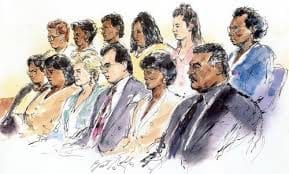Batson v. Kentucky is again front and center in the United States Supreme Court. On May 26, 2015 the Court granted certiorari in Foster v. Chatman, (No. 14-8349, 2015 Term). The case is currently set for argument on November 2, 2015. In Foster, Georgia prosecutors struck all four African-American prospective jurors from the death penalty venire and provided roughly a dozen “race-neutral” reasons for their peremptory strikes. At trial (and on direct appeal) the Georgia court denied Foster’s claim of race discrimination under Batson, 476 U.S. 79 (1986). However, during collateral attack Foster obtained the prosecution’s notes from jury selection which revealed an explicit reliance on race during the jury selection process. African-American jurors had been highlighted, identified by race, and ranked against one another. The Supreme Court granted certiorari to decide whether the Georgia courts committed error during state habeas proceedings by failing to recognize racial motivated use of peremptories by the Georgia prosecutors. In Texas, the legislature enacted TEX. CODE CRIM.PROC. art. 35.261 to implement Batson.
Rarely will our Batson challenges involve such obvious use of race in the State’s exercise of peremptory strikes. Consequently, developing a Batson claim during jury selection is hard and detailed work, especially after a long and tiring day. To effectively identify Batsonviolations, we need a thorough system for recording all aspects of the jury selection process. One method is utilizing a spreadsheet to record each venire member’s race, gender, physical appearance, and other important attributes. Additionally, our system should record the number of questions asked of each juror, the type of questions asked, and all statements made by the juror. Hard work, indeed! Ideally, a separate member of our defense team prepares these notes. Accurate records will be critical for identifying similarities between venire members struck and those accepted by the State.
After the State exercises their strikes we must establish a prima facie case of racial discrimination. Essentially, we accuse the prosecutor of racial discrimination by virtue of their peremptories. Our objection must be reasonably specific. Invoking Batson or Article 35.261 will usually be sufficient to merit review. Make sure the entire voir dire examination, your objections, and your prima facie case are on the record. Furthermore, the record must be clear concerning the race of the jurors peremptorily struck by the State, as well as the race of other members of the jury venire. Once your prima facie case is on the record, the burden shifts to the prosecution to articulate race-neutral reasons for their strikes. Be sure these are on the record. Next, the burden shifts back to the defendant to rebut the explanations. See Williams v. State, 804 S.W.2d 95 (Tex. Crim. App. 1991), cert. denied, 501 U.S. 1239, 111 S.Ct. 2875, 115 L.Ed.2d 1038 (1991). The trial court’s Batson rulings are reviewed on appeal under the clearly erroneous standard of review. See Gibson v. State, 144 S.W.3d 530 (Tex. Crim. App. 2004).
The prosecutor may be someone you work with every day . . . maybe even a friend. When challenging their strikes you are essentially accusing them of purposeful racial discrimination. You are also accusing them of lying about it. Another rarely articulated problem is the dynamic created between the judge and prosecutor when we make our Batson challenges. Is the trial judge predisposed to find in your favor? The prosecutor is someone the judge works with day-in and day-out. Are they likely to rule the prosecutor is both a liar and a racist?
Hence, you must be prepared to make a detailed and satisfactory record. Developing evidence to support racial discrimination can take several forms. Use the data complied on your spreadsheet to argue that race-neutral justifications offered by the prosecutor were simply not true. Or assert the prosecutor mischaracterized the struck juror’s responses to voir dire questions. You may argue the facts identified by the prosecutor, while true, were not disadvantageous to the prosecution. (e.g., the minority juror had a close connection to law enforcement). Examine whether reasons given for a challenged strike apply equally to an accepted juror. This is called comparative juror analysis. Texas appellate opinions have stressed that comparisons of similarly situated jurors constitute perhaps the strongest evidence relevant to Batson claims. See Whitsey v. State, 796 S.W.2d 707 (Tex. Crim. App. 1989)(opinion on rehearing); Esteves v. State, 849 S.W.2d 822 (Tex. Crim. App. 1993). You may also compare the disparate treatment of minority versus non-minority jurors. For example, examine the number (or type) of questions asked of a minority panelist regarding family members involved in the justice system compared to the number of similar questions asked of non-minority panelists. Discuss the numerical use of strikes on minority jurors, as well. (e.g., 3 of 4 African-American jurors struck). Remarkably, prosecutors may be trained to articulate satisfactory race-neutral reasons for striking minority jurors. See Top Gun II Batson Training: Articulating Juror Negatives in the Race Materials Bank at www.ncids.org (select “Training and Resources”); see also Miller-El v. Dretke, 545 U.S. 231 (2005)(discriminatory training manual on exclusion of African-Americans from juries constituted evidence supporting Batson violation). Finally, be sure all relevant materials are made part of the record in the event your Batson claim is denied and your client is convicted including jury questionnaires, information about denied discovery requests, and other pertinent materials.
The Batson challenge is still a viable weapon in our arsenal for protecting the accused’s right to equal protection of the law. More importantly, Batson helps us protect the right of minority jurors to participate in our system of criminal justice. When minority jurors are blocked from jury service the trustworthiness of the judicial system is diminished. And scarcely does the minority community believe they received a fair shake from an “all-white” jury. Consequently, a good record system and effective comparative juror analysis may be key to our success at trial or on appeal. It’s really hard work, but so important as we safeguard the integrity of our client’s right to a fair and impartial trial.
(“Off the Back” featured in the “Voice For The Defense” October 2015)
Stephen Gustitis is a criminal defense lawyer in Bryan-College Station. He is Board Certified in Criminal Law by the Texas Board of Legal Specialization. He is also a husband, father, and retired amateur bicycle racer.
“Off the Back” is an expression in competitive road cycling describing a rider dropped by the lead group who has lost the energy saving benefit of riding in the group’s slipstream. Once off the back the rider struggles alone in the wind to catch up. The life of a criminal defense lawyer shares many of the characteristics of a bicycle rider struggling alone, in the wind, and “Off the Back.” This column is for them.
Related Posts:
Areas of Practice – Expungement
Warrants Required for GPS Tracking





